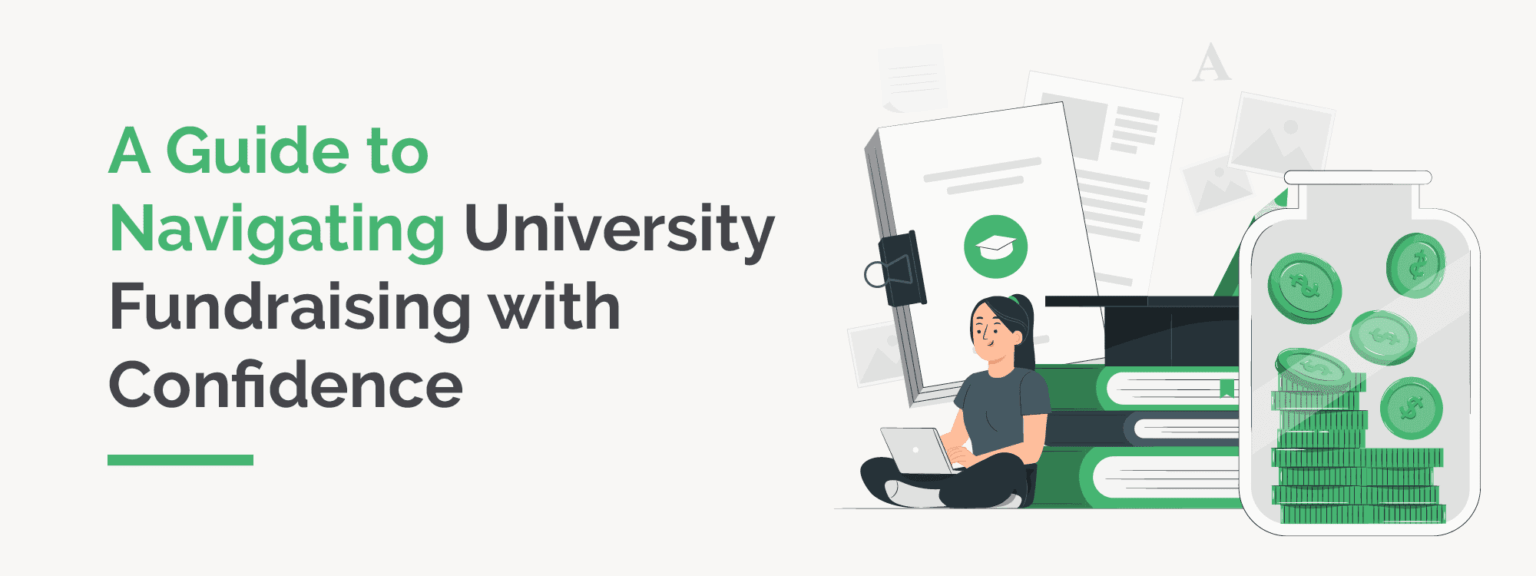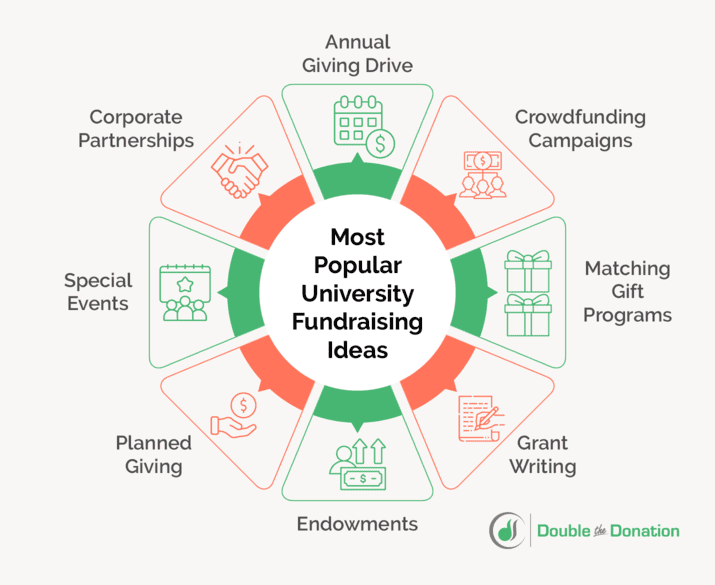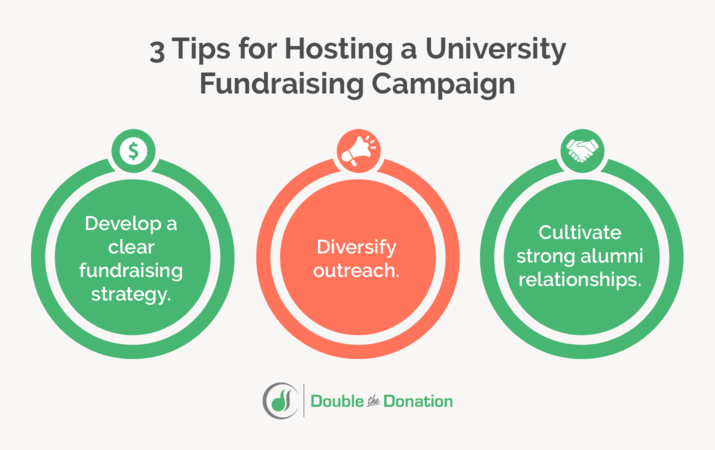A Guide to Navigating University Fundraising with Confidence
Fundraising is the backbone upon which universities are built, helping to expand educational offerings, enhance campus infrastructure, and prepare the next generation of changemakers.
University fundraising, however, is not merely about securing financial contributions; it is a delicate and multifaceted dance of identifying your need for support, articulating the profound impact of your institution, and cultivating long-term relationships with donors.
With philanthropic giving to higher education increasing by 12.5% in 2022, donors are becoming increasingly more inclined to contribute to colleges and universities. Equipped with the most up-to-date information about university fundraising, you’ll be set to engage donors and garner their support.
In this guide, we’ll cover everything you need to know about university fundraising, including:
- Emerging University Fundraising Trends
- The Most Popular University Fundraising Ideas
- 3 Tips for Hosting a University Fundraising Campaign
Whether you’re a seasoned professional looking to refine your approach or a newcomer seeking a strong foundation of knowledge, these insights will help you build a sustainable fundraising program that stands the test of time.
Emerging University Fundraising Trends
Higher ed fundraisers have to stay up-to-date with evolving donor expectations, technology advancements, and shifting societal priorities to remain competitive and relevant in a dynamic philanthropic landscape.
Here are three university fundraising trends to be aware of:
- Digital fundraising: With the increasing prevalence of online communication and giving platforms, universities are leveraging digital channels to engage donors and raise funds. This includes the use of crowdfunding campaigns, virtual fundraising events, and social media outreach to reach a broader and more diverse donor base. Digital fundraising also allows for data-driven strategies to maximize donor engagement and contributions.
- Impact philanthropy: Donors increasingly seek transparency and accountability in how their contributions are used. Universities are responding by emphasizing the impact of philanthropic gifts and providing clear metrics on how donations are making a difference in areas such as scholarships, research, and community outreach. This trend encourages donors to align their contributions with specific initiatives that resonate with their values.
- Ethical fundraising practices: Universities are embracing sustainable and ethical fundraising practices that prioritize long-term relationships with donors and the well-being of the institution. This includes a focus on ethical stewardship of donor relationships, a commitment to diversity and inclusion in fundraising efforts, and adherence to best practices in data privacy and security to build trust with donors.
Universities that adapt to these trends can position themselves for success in engaging donors and securing the resources needed to advance their missions.
The Most Popular University Fundraising Ideas
As you review the following fundraising ideas, consider how you can adapt them to align with your specific needs and alumni base.
Annual Giving Drive
The primary goal of an annual giving drive is to generate unrestricted funds that can be used to support the institution’s immediate and ongoing operational needs, such as scholarships, faculty support, program development, and infrastructure maintenance.
Some institutions may choose to run their annual giving drives on a fiscal year schedule rather than a calendar year schedule. Regardless, structure your campaign around this timeline:
- Pre-campaign planning (11-12 months before the deadline): Form a campaign committee or team responsible for planning and execution. Work together to determine how much money you need to raise, what the funds will be used for, and how the contributions align with your institution’s overall mission.
- Campaign preparation (9-10 months before the deadline): Develop a compelling case for support and prepare a launch plan that includes a coordinated announcement across channels.
- Active campaign period: Reach out to potential donors through personalized and targeted communication efforts, whether that be through direct appeals, phone calls, or email campaigns. As the campaign nears its end, leverage urgency in your calls to action to ensure your goal is met.
- Campaign evaluation (1-2 months after the deadline): Review donor data and assess the effectiveness of your segmentation and communication strategies. Share the impact of the campaign and how donations have been used.
It’s important to note that you may need to adjust the specific timeline for your annual giving drive based on your institution’s unique circumstances and objectives.
Matching Gift Programs
Matching gifts are a philanthropic practice in which employers, often corporations, financially match their employees’ charitable contributions to nonprofits and universities. When a university fundraiser secures a donation from a donor whose employer offers a matching gift program, the impact on university fundraising can be substantial. It essentially doubles the donor’s initial contribution, significantly increasing the total funds raised for the institution.
This matching process not only boosts the university’s financial resources but also encourages donors to give more generously, as they recognize the added impact of their contributions.
To encourage donors to leverage matching gifts, take these steps:
- Raise awareness. 78% of donors are unaware if their company offers a matching gift program, so it’s important to raise awareness of these giving opportunities. Include information about matching gift programs in your fundraising communications and on your university’s website. Ensure that donors are aware of the existence and benefits of these programs, and provide clear instructions on how to participate.
- Engage corporate partners. Build relationships with local and national corporations to encourage them to establish or expand their matching gift programs. Collaborate with corporate partners to promote the program to their employees and alumni, facilitating a seamless matching gift process.
- Simplify the process. Make it easy for donors to submit matching gift requests with Double the Donation. The platform automatically sends donors the information they need to complete their match and follows up when needed. Plus, it allows universities to track the progress of matching gift submissions in one easy-to-use interface.
Watch the video below to learn how the University of Lynchburg leveraged Double the Donation to streamline its matching gift process and generate increased revenue:
As you’ll see, Double the Donation makes it easy to double the impact of your university fundraising efforts. To get started, request a demo!
Crowdfunding Campaigns
For university fundraisers, crowdfunding can be a lucrative venture because it harnesses the power of the collective, tapping into a broad network of donors who are passionate about the university’s mission and projects, potentially resulting in substantial financial support from a diverse group of contributors. Even students can get involved, with nearly 8% of current students contributing to crowdfunding initiatives.
When you launch a crowdfunding campaign, be sure to:
- Set clear and specific goals. Define clear and measurable goals for your crowdfunding campaign, such as the amount of funds you aim to raise, the project or initiative you’re supporting, and the timeline for the campaign. Specificity helps donors understand the purpose and urgency of their contributions.
- Engage your university community. Use various communication channels, including social media, email newsletters, and campus events, to raise awareness and encourage involvement. Engage volunteers and ambassadors who can help spread the word and reach a wider audience.
- Facilitate student-led fundraising. Consider creating dedicated sections or sub-campaigns on your crowdfunding platform where student groups, clubs, or organizations can create their own fundraising initiatives. Provide guidelines and support to help student groups set up and manage their campaigns effectively.
Use the momentum generated by the crowdfunding campaign to build on the success and cultivate ongoing relationships with donors for future fundraising initiatives.
Grant Writing
Pursue grants from government bodies, private foundations, and corporations to fund research projects, academic programs, and infrastructure development. Leverage these grant-writing tactics to increase your win rate:
- Understand the grantmaker’s priorities. Before you begin writing a grant proposal, thoroughly research the grantmaker’s mission, goals, and funding priorities. Tailor your proposal to align with the specific areas of interest or focus outlined by the grantor.
- Craft a compelling narrative. Tell a persuasive and engaging story in your grant proposal. Use clear, concise language to convey the significance of your university’s project or program. Highlight the potential impact on students, research, or the community, and provide concrete examples and evidence to support your claims.
- Address the grant requirements. Pay close attention to the grant application guidelines and requirements. Ensure that your proposal meets all specified criteria, including format, word count, submission deadlines, and any requested attachments or supporting documents. Failure to adhere to these guidelines can result in your proposal being disqualified.
Grantmakers often want to see that their funding will have a lasting impact. Therefore, you should also outline a clear plan for the sustainability of your project or program beyond the grant period.
Corporate Partnerships
Corporate sponsors provide universities with a stable source of financial support that can enhance academic programs, scholarships, and research initiatives. Plus, the partnership can strengthen the university’s reputation and attract philanthropic contributions from other sources.
Take these steps to establish strong partnerships with businesses:
- Research and identify alignment. Research potential corporate sponsors to identify organizations that align with your university’s mission, values, and goals. Seek out companies with a history of supporting educational initiatives or whose corporate giving priorities align with your institution’s programs.
- Create customized proposals. Tailor your sponsorship proposals to the specific interests and needs of each potential corporate sponsor. Outline the benefits and opportunities that partnering with your university can offer, such as brand exposure, access to a talented pool of students, research collaboration, or community engagement.
Once you’ve secured a corporate sponsor, maintain a strong and transparent line of communication. Regularly update them on the progress of their sponsorship, including the impact of their support and any milestones achieved. Sharing success stories, data, and reports demonstrating the tangible results of their partnership reinforces their commitment and fosters a sense of ownership and pride in the collaboration.
Endowments
Endowments encompass invested donations that grow over time to provide increased value. Educational institutions can use this university fundraising tactic to fund:
- Scholarships: Endowments often support scholarships and financial aid programs, ensuring that deserving students have access to higher education regardless of their financial circumstances. These funds can cover tuition, fees, books, and sometimes even living expenses.
- Professorships: Endowments can be designated to attract and retain top-tier faculty members and provide resources for cutting-edge research and academic excellence.
- Research programs: Lastly, endowments can fund university research programs. These funds may provide the school with research grants and fellowships, equipment, new research centers, or seed funding for pilot projects.
Creating endowments for your university is beneficial because it provides your institution with a stable source of income. This type of fundraising also attracts major donors, allowing you to build relationships with supporters who have the highest giving capacities.
Planned Giving
Encouraging donors to include your university in their estate planning can lead to long-term, reliable financial support. Identify donors who are nearing retirement or already retired, have a history of significant contributions, and are actively involved—these are prime candidates for planned giving.
Then, appeal to these prospective donors, keeping in mind that:
- Timing and context are crucial. Choose the right moment and setting for your discussion. Invite prospective donors to a formal face-to-face meeting or virtual conversation where you can devote ample time to the topic without distractions.
- Planned giving is a sensitive topic. Instead of directly asking donors whether or not they want to invest in planned giving, you might inquire about their long-term philanthropic goals, their connection to the university, or their aspirations for leaving a legacy. This approach allows donors to express themselves freely and can naturally lead to discussions about their estate.
- The benefits may be unclear. If donors express an interest in planned giving, walk them through the benefits, mentioning the opportunity to leave a lasting legacy on their alma mater and receive significant tax advantages. Additionally, explain their giving options, including bequests, charitable trusts, and gift annuities.
Because planned giving often involves complex financial arrangements, you should consult with legal experts throughout this process to ensure compliance with relevant laws and regulations.
Special Events
Fundraising events can attract significant donations and enhance your networking opportunities. For the best results, host events that are creative and will inspire a large turnout like:
- Art auction gala: Host an elegant evening featuring an art auction with pieces donated by alumni, faculty, and local artists. The event combines the appreciation of art with philanthropy, allowing attendees to bid on unique artworks while supporting the university’s initiatives.
- Taste of the world festival: Celebrate cultural diversity by organizing a food and cultural festival. Invite local vendors and international student organizations to showcase their cuisine, music, and traditions. Attendees purchase tickets to taste various dishes, with proceeds benefiting international programs or scholarships.
- Student talent show: Showcase the talents of students, faculty, and staff in a talent show or variety performance. Sell tickets for entry and use the proceeds to support student scholarships or arts programs.
- Campus scavenger hunt: Organize a campus-wide scavenger hunt where participants follow clues and solve puzzles to discover hidden treasures or landmarks. Participants pay an entry fee, with funds raised going towards campus improvements or student initiatives.
Throughout the event planning process, consider how you can engage potential donors who may not be able to attend the event in person. For instance, when hosting a scavenger hunt, you might add an exclusive map to your website or mobile app that allows attendees to participate virtually.
3 Tips for Hosting a University Fundraising Campaign
As you prepare to launch your next university fundraising campaign, keep the following tips in mind to ensure it’s a success.
1. Develop a clear fundraising strategy.
Define your university’s fundraising goals and priorities. Establish a comprehensive plan that outlines the specific projects, initiatives, or areas that require funding.
Be sure to identify your target donors, whether they are alumni, corporations, foundations, or individual philanthropists, and tailor your strategy to appeal to their interests and values.
2. Diversify outreach.
Donors have varying communication preferences and motivations for giving. Using a mix of channels, including social media, email, direct mail, phone calls, and in-person events, caters to these preferences and increases the likelihood of engagement.
In addition to more traditional methods, you may incorporate more unique outreach opportunities like eCards. When you thank your donors or invite them to an event with an eCard, you grab their attention and communicate with them in a more interactive, exciting way.
You may also reach potential supporters through Google Ads. With the Google Ad Grant program, philanthropic arms of higher educational institutions can unlock $10,000 in Google Ad credits for free. This way, your organization can show up at the top of the search results for relevant searches and secure more support.
For the best results, segment your donor list based on factors like giving history, affinity to specific university programs, and communication preferences, and personalize your outreach accordingly.
3. Cultivate strong alumni relationships.
Alumni who feel connected to their alma mater are more likely to contribute. That’s why it’s important to engage with your alumni community on a regular basis, not just when you need their financial support.
Stay in touch through regular newsletters, social media updates, and invitations to alumni events. In addition, recognize their accomplishments and contributions to the university, seek their input on important initiatives, and provide opportunities for alumni to mentor or support current students.
A Final Note About University Fundraising
Remember that the fundraising landscape is not a fixed path but a vast terrain of opportunities waiting to be explored. With each step, you can gain experience, build lasting relationships, and contribute to the enduring legacy of higher education.
For more information on university fundraising, review these additional resources:
- Conduct a Fundraising Feasibility Study: 7 Steps to Success. Conduct a fundraising feasibility study to see if your university is ready to launch a major giving campaign.
- Donor Stewardship: How to Retain Support Effectively. Take these steps to steward long-lasting relationships with donors.
- 40+ Matching Gift Companies: Find Your Match Today. Review which companies offer matching gifts. Chances are your alumni works for at least one of the companies on this list.







